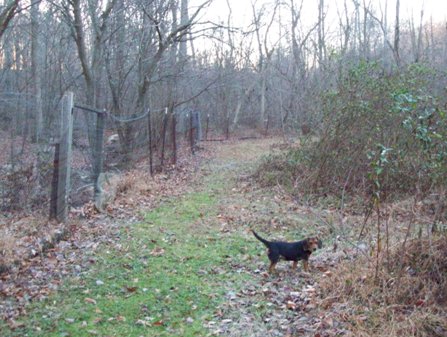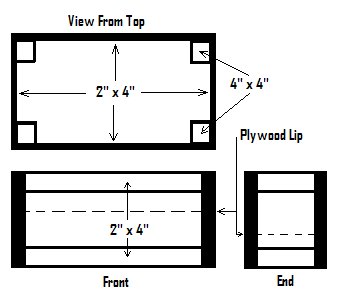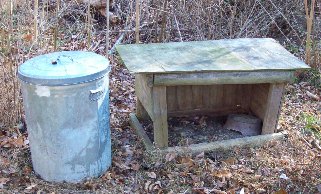|
STARTING PEN DESIGN by Bruce
Gabrielson In part 1 of this series we concentrated on selecting the type of pen you need based not only on what your short and longer-term goals were, but also on how much you are able to spend. This part will address basic design approaches including the proper use of drainage and cover. Simple Designs A simple design is just that, a square plot of land set aside for your training area. It could be flat or sloped, and can include trees or other types of vegetation. However, there are some subtle things as you will soon realize that really do effect how your rabbits or hounds will view your pen. These subtle things related to your pen include the general outline; how you place brush piles, feeders, and water sources around the pen; the grass and cover; exposure to wind and snow; what you do about trees; drainage; and finally how you are equipped to deal with young rabbits. The Pen's Outline Since I've previously discussed size requirements, lets start with the pen's outline. Many people simply fence off a square area, let the grass grow long, mow some strips, and put in a few brush piles and feeders/waterers. This will work provided: 1. You have a very small or very large pen. 2. You don't want to raise any natural rabbits. 3. You don't plan to run more that one or maybe two dogs at a time and then only under direct supervision. 4. You don't plan to work anything during the winter months. 5. You don't mind spending much time dealing with micro management issues. I have learned a few things about pen outlines on my own over the years that have worked for me and these may be useful to you as well. The following was first noted when exercising my old hounds, two at a time, in my pen. You might not realize it unless you watch, but rabbits like to have an area in a pen where they feel safer than other areas. They won't necessarily stay in this area all the time, but they will tend to head there when they get tired. On the other hand, Beagles are often one minded when it comes to jumping rabbits. They tend to go in straight lines. When you build a smaller L-shaped side area in a pen outline the rabbits will often head to this area when tired, while the hounds will often miss this area on a regular basis when searching. Below (Pic #1) is the general outline and design of my current pen. We will come back to this picture again. While there are several changes I've had to make over my pen's original outline based on problems I've discovered, the two almost L-shaped sections are obvious.
Initially I ran the fence between 2 and 4. What I noticed was tired rabbits and young rabbits tended to be found more often near position 5. At first I thought it was simply because the waterers and my feeders were near there. Then I had a summer when it rained all the time and I had added a few more feeders. The same thing happened. When many of my rabbits moved to position 3 after I expanded my pen the next year I really started to look at what was going on and made an interesting discovery. It seems that both my just starting pups and my older dogs would work nearly straight across between position 2 and 4 and from there to position 6. Only once in awhile did they work near 3 or 5, even though they almost always jumped several rabbits in those areas. Since I also found two litters in that area last summer, my plan now is to move the fence line even farther back from position 3 as I think this may be the answer to one of my concerns, an area where rabbits feel safer.
Brush Pile Placement Still discussing corners, in my pen all corners have a brush pile within three feet of the fence line corners, plus I allow the grass to grow high in the corner itself. I leave just enough room to easily mow my path near the fence, and even find rabbits hiding in the small corner clump of grass every now and then.
Besides corners, my brush piles tend to be placed in random but parallel locations around my pen except near the fence line. Here I've placed numerous long piles within about 3 ½ to 4 feet of the fence itself. This allows me to mow and inspect along the fence line, plus rabbits always have an open path to run if they chose to do so. The first figure (Pic #4) shows a typical brush pile on one side of the path along my fence line.
Allowing for inspections is extremely important if you want to keep your rabbits inside. I live in an area with plenty of foxes, plus I get smart Beagles on occasion who know how to dig or chew. Another good source of holes is the snapping turtle. They have both long claws and strong jaws. There have been several times when I've found a snapper that has dug through my apron and then under my fence. I also have a constant problem with branches falling on my fences and with vines growing on my fences. For these reasons, I suggest you not only have a clear view of your entire fence line, but that the fence also gets inspected on a regular bases, even when it snows. The second picture (Pic #5) shows one of the open paths along my fence line. I try to leave plenty of room for the rabbit to run and also enough room for my riding mower to cut the grass along the fence. I've also placed brush piles near feeders and waterers. The piles reach almost to the feeder or waterer itself to reduce the problems I might have with hawks and owls at night hanging around specific rabbit locations. Drainage I learned this lesson the hard way after several years of loosing young rabbits no matter how seldom they were worked or how much room they have. Rabbits can't be exposed to the elements, and their bedding areas can't get wet. One spring my creek overflowed causing quite a bit of water to build up in parts of my pen. It turned out that the higher spots in my pen weren't necessarily where the rabbits were located and many died. Because of the standing water, I next added the L-section previously discussed. There is a slight rise in this area, and it is heavily covered with evergreen trees. We had several days of heavy rains this past spring and what a difference. Large numbers of rabbits huddled on my hillside. Another interesting item I've discovered is that there are now burrows all over the hillside and most of my baby rabbits come from this area. This reminded me of a close friend in Ft. Wayne many years ago who had problems keeping his rabbits. He had someone dig a pond in his pen and the dirt was simply piled high on the side of the pond. After a short while he found that despite the lack of heavy brush, many rabbits in his pen nested on this hill, plus he could always jump something there. This reminds me of still another similar item. At my Beagle club there is a hill and creek bottom gully running across one back area of the grounds. This seems to be one of the most populated areas of the grounds as well. Weather Exposure Direct exposure to the elements is a problem for rabbits. I've discussed how to build brush piles for good cover in previous articles. My concern here is that rabbits must have a place where they can get out of the rain and sun, where they aren't going to be snowed in for long, and where they can keep warm. If you have an exposed field, dig a trench, pile the dirt alongside, and plant thick brush for the rabbits to hide in and to break the wind. Waterers and Feeders The waterers in my pen are really two smaller concrete and wire fish ponds I've dug. What's interesting is that they are located directly in the normal drainage path through my grounds, and are continuously refilled and kept clean whenever it rains here. About the only problem I have is making sure the mosquitoes don't get bad when we get a longer hot dry spell here. I've stocked these two ponds with mosquitoe fish and they haven't seemed to wash out unless there was a real big storm. Even then I have only had the one stocking in 7 years despite 5" thick freezing in the winter. Notice on my map that the two waterers are located across the pen from the creek and near to the areas where heavier concentrations of rabbits are located. When I had only one pond the rabbits would congregate near my kennels in very hot weather. After a lot of vocal unrest by my hounds I put in the second pond and no problems now. One other point about the waterers is that you need to leave some low shade trees near your ponds. You don't want direct sunlight to heat the water too high and you do need some cover. However, you need to also understand that when leaves drop you will have to clean out the pond. I think evergreens near my pond might have been better that the maples I have now.
Feeders are a little different than waterers. My feeders are placed on high ground so they don't get wet or muddy inside. The usual design is shown above left (Pic #6) with a plywood lip from the top down on each side. Sometimes if the feeder is exposed, I'll completely cover a side with plywood for better protection. I build my feeders higher than most people with a lip on three sides covering about 10 " down, then cover with a removable top. The idea is to let the rabbits crawl into the box to reach feed pan while also allowing enough air space to be accessible even when it snows heavily. The condition is shown above right (Pic #7). I put the plastic feed pan towards the back inside and keep a plastic waterproof trash can with refill rabbit feed close by. Notice the low brush hanging over for nearby cover in the photograph. I don't like having trees above my feeders because of owl problems, but low brush seems to work fine for the rabbits. My feeders have survived a few two foot + snow drifts with no access problems. However, I sometimes dig a sloping ramp into the pan if the snow is deep. Food and Other Cover So far so good on the pen design but some of your cover also need to be eaten. I am a strong proponent of feed strips. Since I've got a lot of trees, my feed strips are about 2 feet wide and located in the middle of my paths. The ground cover in my pen consists of blue grass and clover. Some grasses don't provide enough nutrients but this combination, which is planted in all my paths, works great. You still have one problem with healthy growth, plants need sunlight and mowing to stay thick. During the spring and summer, my paths need mowing to stay lush once every two weeks. I only mow half the paths each week as hounds will have a difficult time running for a day or so after I mow. I've set my mower to it's highest setting so I won't hit the many roots growing all over my pen, plus I don't want the grass cut so low it doesn't grow quickly. The root problem was another "hard learned" lesson. I bought a new mower and the first time I rode it in my pen one of the cutting blades dug into a root and bent. When you notice a root is starting to get high, cut it out with a chain saw and ax. I didn't and it caused me a real problem. Speaking of roots, you absolutely must keep your trees in check or they will block out all sunlight and kill your grass. You end up with mud paths rather then grass paths. I've found that I must constantly carry hedge clippers with me in the winter to cut all the new trees down. New trees seem easier to cut in winter. Also, cut down a big tree or two every year so that sunlight doesn't get blocked. My large trees shed leaves in the fall. I originally had a problem with these leaves killing the grass underneath leaving my undergrowth desolate for winter. Now I run my mower over all paths after the leaves have fallen while directing the blower towards the sides of my paths. You only need to do this a few times in order to keep your paths in good shape all winter. Brush Problems I live in an area where poison ivy, nettles, and other nasty things grow all over the place. This calls for serious control measures. First, before you put up your fence and add any rabbits, give your area a good general spraying with leafy plant killer and then let it sit for a couple of weeks. Next, I like to spray brush remover along my entire fence line at least twice each year, in late spring and late summer. That keeps both the vines down and also helps prevent rusting along the bottom of your fence. Brush killer rather then weed killer works best as it will also control trees growing through your fence and apron. Finally, I spray weed killer in limited amounts directly on every new ivy or nettle plant I discover. This involves a regular walk throughout my pen every few weeks. Be careful to keep your spray area localized or you will risk poisoning your rabbits. Also, try to spray right after a rain storm if possible. I have one suggestion on the weed killer spray, don't spray your briar patches. Rabbits seem to favor this type of brush. I keep my briars controlled but not destroyed. Part 3 of this article will address fence design and installation. All articles are the copyrighted
property of the author |
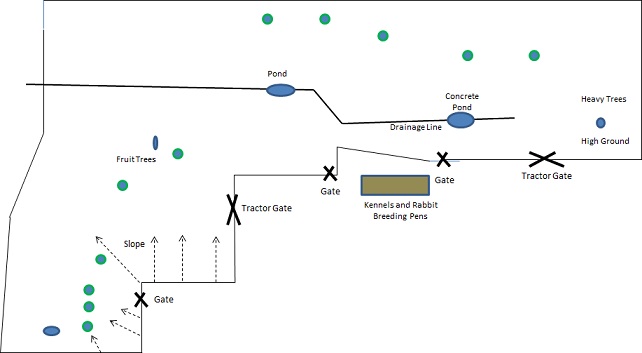
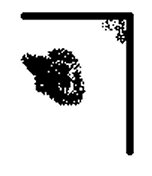 Another item about fence lines is that you absolutely can't have places along
your fence line where rabbits might get trapped, particularly at inner fence
corners.
Another item about fence lines is that you absolutely can't have places along
your fence line where rabbits might get trapped, particularly at inner fence
corners.
